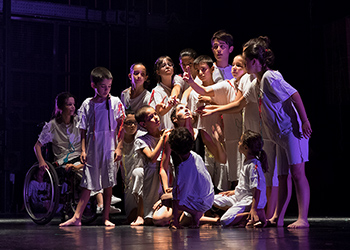The superpower of movement

In the Estrela Academy, over 40 children rehearse for their big day at the Gulbenkian Foundation. Under the supervision of Ana Rita Barata, choreographer and artistic director of the Vo’Arte Association, and the ballet dancers Bruno Rodrigues, Cecília Hudec, Joana Gomes and Mara Pacheco, from the dance company CiM, in amongst laughter, jokes and other complicit exchanges, the choreographies take shape. This is one of the first rehearsals since the performance EU MAIOR (I GREATER), premiered in June 2017 at the São Luiz Theatre, which resulted from work undertaken by around 1,200 children (17 classes) from the Padre Bartolomeu de Gusmão and the Vergílio Ferreira school groups, between 2016 and 2017, within the scope of the Generation SOMA project. This is one of the 16 projects that received support from the second edition of PARTIS – Artistic Practices for Social Inclusion, set up by the Calouste Gulbenkian Foundation in 2013.
The 12 multidisciplinary artists/educators from the CiM artistic team took part in the curricular program of the 17 participant classes. The challenge launched was to awaken the superhero in each one of us, based upon the belief that we each have within us a hidden superpower, a counterbalance to that which makes us vulnerable. After identifying their fragilities, the children created four characters based upon which four stories are developed through the narrative of this performance. One features Joana, a blind dancer who develops the superpower of hearing with her skin, transforming her fragility into movement.
The inspiration for the project came from hese children’s imaginaries and the strength contained within it, alongside the will to try another type of approach with the children with special needs, for whom so very often access to the “normality” that took shape in this project is otherwise denied. According to Ana Rita Barata, the inclusion of children with special needs is essential. “My daughter was studying at elementary school and one day she told me that she could not go into the playground because the handicapped boys were there. They were scared that they would get hurt, hit with a ball in the face…” But can a child be happy without ever running risks? “A child has to move, has to live. It is necessary to learn how to deal with a ball in the face!”
Ana Rita considers our education system to be “obsolete”, given that the teacher-adult relationship is highly sterile and limited and hence the teacher “has to be so highly creative so as to be able to convey something new and capture the attention of students” while simultaneously complying with the school program. Projects such as Generation SOMA are a complement to the mission of a teacher, a way of “getting children out of their chairs”, working their physicality, the awareness of their body and their movements and simultaneously learning to be in the classroom and working with attention, in silence and with critical and creative thinking.
The project implementation process in schools proved “long and difficult” and was received with a certain distrust by the parents and guardians with “meeting after meeting taking place”. However, after having embarked on the challenge, the feedback quickly became very positive. The parents soon noticed changes in their children, guaranteed Ana Rita. We may, for example, take the case of Ana Beatriz, a child with Trisomy 21 who, when the program began, did not relate to anybody in the school, “was always in a corner, quiet and alone”. Those who see her now in the rehearsals simply do not recognise her: relaxed, talkative, playful, the child is happy. This is what Ana Rita terms the side effects of this program, “which are incalculable”. Far from the school environment, from the ridicule of colleagues, the rehearsals become “a space without filters”, in which the experience of the collective becomes one of mutual assistance, “inclusivity”, dance and music. For these children, it is “as if they had found their place in the world”.
Generation Soma: the performance and the future
Of the 65 children who volunteered to participate in this performance, nine belong to the Trifonética Orchestra, made up of children with integrated music teaching. The performance music, composed by Philippe Lenzini, was produced in conjunction with suggestions from these young musicians and the ongoing choreographic work. What is to be presented on 20 February is an improved version of EU MAIOR, with a greater focus on the story and on communicating the narrative.
This event is one way of displaying this inclusive and social project that works with children aged between five and 16 at primary schools in Lisbon, some of which cater for children with special education needs, and their respective educators (teachers and parents), through artistic creativity and practice.
Developed by Vo’Arte (an association that strives to foster creative dialogues between the various artistic spheres within the objective of deepening the relationships between different communities and cultures), in partnership with CiM (which has brought together performers with and without disabilities for the last decade), this project, launched in 2015, now has the chance to show off its work at the Gulbenkian Foundation, the “mother-host of this project”.
This presentation represents the final stage in a project that for the meanwhile has no clearly defined future. The will to continue exists and ideas for a “This is PARTIS 3” are in abundance. In the plans of Ana Rita Barata, there is “a pilot-project that enables the adoption of a multidisciplinary approach to children in schools”, bringing together different activities from within and beyond the school, from dance to camping, for example. For now, the struggle to change paradigms is underway alongside the invitation to come and discover the results of the work already done.
